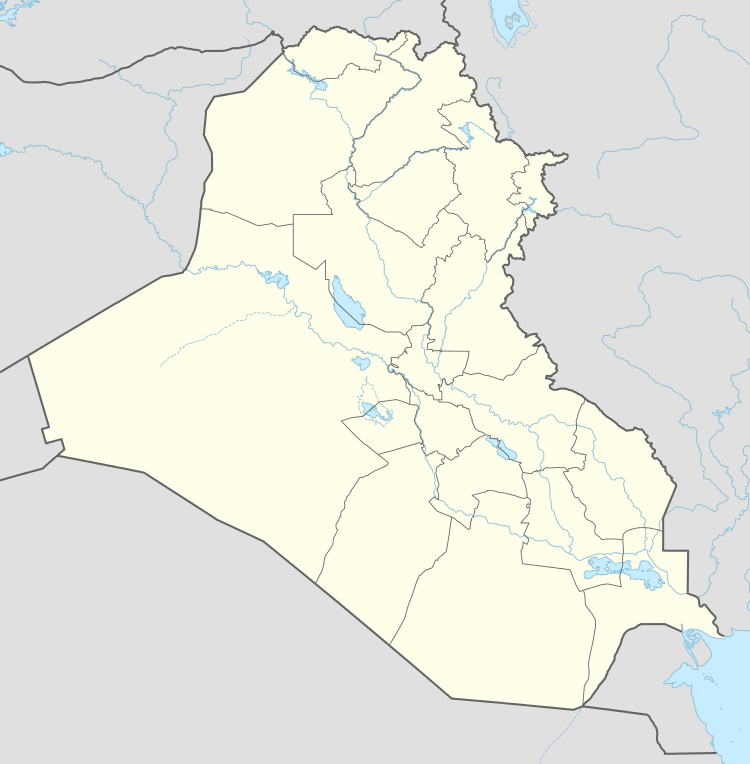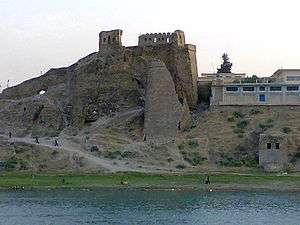Bash Tapia Castle
| Bash Tapia Castle | |
|---|---|
| باشطابيا | |
| Mosul, Iraq | |
|
Ruins of Bash Tapia Castle in 2014 | |
 Bash Tapia Castle Bash Tapia Castle | |
| Coordinates | 36°21′19.4″N 43°7′17.7″E / 36.355389°N 43.121583°E |
| Type | Castle |
| Site history | |
| Built | 12th century |
| Materials | Stone and stucco |
| Fate | Destroyed, 2015 |
| Battles/wars | Ottoman–Persian War (1743–46) |
Bash Tapia Castle, (Arabic: باشطابيا) also known as Bashtabiya Castle or Pashtabia Castle, was a 12th-century castle located on the western bank of the Tigris river, forming part of the city wall of Mosul, Iraq. It was destroyed by the Islamic State of Iraq and the Levant (ISIL) in April 2015.
History
Bash Tapia Castle was built in the 12th century as one of seven castles within Mosul's city wall. The castle was damaged by Timur in 1393, and was later rebuilt by the Ottoman Empire.[1]
Bash Tapia Castle played an important role in the siege of Mosul during the Ottoman–Persian War of 1743–46. The siege began on 14 September 1743 when the Shah of Persia, Nadir Shah, arrived in city. The Pasha of Mosul, Hajji Hossein Al Jalili, successfully defended the city, and the siege was lifted on 23 October of the same year.[2]
The ruins of the castle were an archaeological site,[3] and were also significant as being one of the few surviving parts of Mosul's walls.[4][5] The castle was a landmark and a symbol of Mosul's identity,[6] and it was popular with tourists from other parts of Iraq and neighbouring countries.[7] It became neglected after the invasion of Iraq in 2003.
Destruction
The city of Mosul was captured by the Islamic State of Iraq and the Levant on 10 June 2014, and Bash Tapia Castle was damaged in the subsequent fighting. A missile fell near the castle on 10 July and damaged its walls,[8] while a drone fired two shells on it on 23 July.[9]
According to reports by the Iraqi Ministry of Tourism, the castle was blown up by ISIL in April 2015 during destruction of cultural heritage by that group.[6][7]
References
- ↑ "Mosul History". mosulbaladiya.gov.iq. Archived from the original on 24 May 2015. Retrieved 24 May 2015.
- ↑ Sicker, Martin (2001). The Islamic World in Decline: From the Treaty of Karlowitz to the Disintegration of the Ottoman Empire. Westport: Greenwood Publishing Group. p. 63. ISBN 027596891X.
- ↑ "ISIS blow up Bashtabiya Castle in Mosul". Shafaq News. 8 April 2015. Retrieved 24 May 2015.
- ↑ "Iraq, to Mesopotamia". busaroundglobe.com. 30 November 2003. Retrieved 24 May 2015.
- ↑ "Iraqi's Heritage". ISESCO. Retrieved 24 May 2015.
- 1 2 "ISIS destroy ancient Bashtabiya Castle in Mosul". RUDAW. 8 April 2015. Retrieved 24 May 2015.
- 1 2 Боевики "Исламского государства" взорвали древний замок Баш Тапия в иракском Мосуле (in Russian). Russian News Agency "TASS". 8 April 2015. Retrieved 22 May 2015.
- ↑ "Updates: Bashtabya castle in danger; ISIS withdraw from their centers; fuel crisis is resolving; and ex-Iraqi Army officers assassinating ISIS leads". mosuleye. 10 July 2014. Retrieved 24 May 2015.
- ↑ "ISIS expands to Mosul Damp; airstrikes on Mosul; displaced homes given away; no electricity; more arrests; and free buses". mosuleye. 23 July 2014. Retrieved 24 May 2015.
